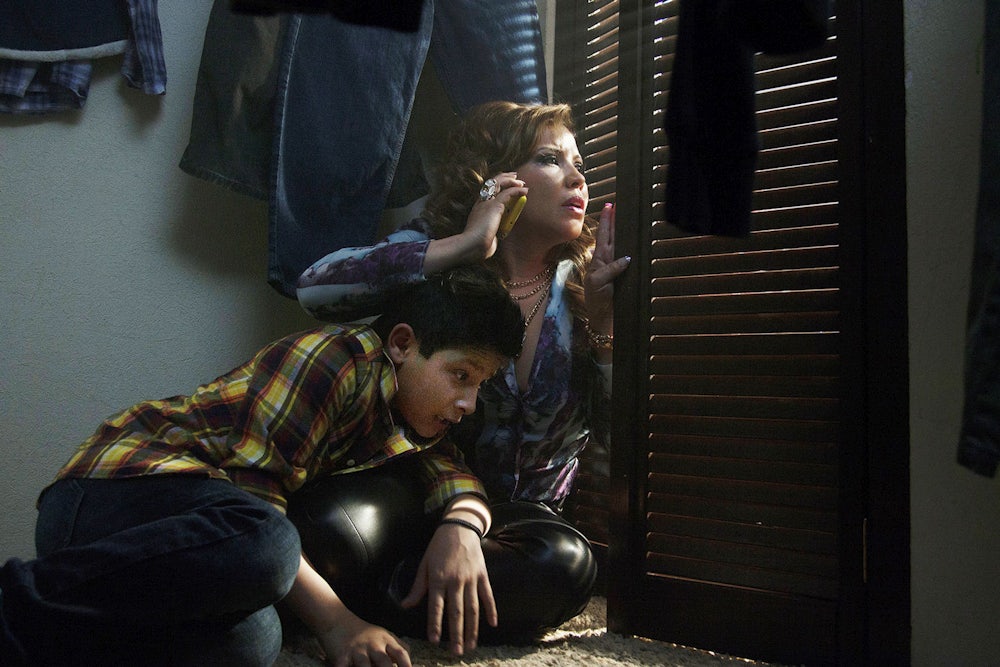The first thought I had when Brenda Parra (played by Justina Machado) is introduced in the pilot episode of the USA narco drama Queen of the South was, “She’s going to die.” Brenda and the show’s main character, Teresa Mendoza (Alice Braga) are the wife and girlfriend (respectively) of two members of a drug cartel who have betrayed their bosses and been killed. The two women are forced to flee for their lives, but before Teresa can drag her friend away, Brenda takes a moment to do a bump of cocaine. Teresa declines.
Taking time to do hard drugs when killers are chasing you is narrative code for “This character deserves whatever’s coming.” (A shot of whiskey, on the other hand, might indicate serious determination.) The show is about Teresa and her drive to survive no matter what. She’s motivated by a vision of her future self as a stylish drug queenpin. The vision whispers encouragement to Teresa from behind her sunglasses when things get really rough, like when a vicious hit-squad member rapes her. Brenda begins the show as her foolish bestie, a contrast with Teresa and a lesson in what would happen to her if she were any less tough.
There’s a visual language to their differences. Braga’s Teresa is exceptionally thin, even by American television standards. Her hair is stringy or pulled back, and her no-makeup-look makeup is often smeared with dirt. The clothes she wears are minimal and utilitarian: A tank top and jean shorts. Everything about her presence is steely and lean, ready to run. Teresa reflects her priorities, which are escape and independence. Brenda is the opposite. She has an hourglass figure, and her hair and makeup are always done in a way that indicates effort. Brenda keeps her cartel wife outfits, not changing into fugitive wear. And she has a child. Against the odds, however, Brenda survives the pilot and crosses the border into America with her young son, Tony.
An undocumented immigrant widow and her son trying to get by, while fleeing the drug war, sounds more like art house cinema than a sexy cable action-drama. But Brenda is not the typical didactically moral immigrant mom, whose misery and exploitation rebuke the viewer’s complacency, and this is not Under the Same Moon. When she ferrets out a rinky-dink drug ring operating out of the motel where she and her young son are staying, Brenda immediately takes over and turns the men into her underlings. She sits on a bench outside a Home Depot, not asking for charity or looking for work, but hustling men who she accuses (in a loud voice) of trying to solicit her. Brenda becomes the American right’s worst nightmare: An illegal immigrant mom drug-dealer blackmailing innocent men with false sexual harassment allegations.
Brenda is also—by far—the show’s most interesting, sympathetic character. In a sea of drug war cliches, she is the only thing that sticks out. At some point, the writers and producers must have noticed that Machado was acting circles around the rest of the cast, including the star Braga. Brenda survives, even as her story becomes more and more tangential. Her fight to save her life feels like a struggle with narrative conventions and genre constraints, as much as with the cartel. But Teresa is most compelling when she’s plotting with Brenda, and the protagonist refuses to ditch her companion even when the script makes it seem like she probably should. For brief moments over the course of its first season, Queen of the South was a show about two friends showing up for each other.
Even though it takes place on and around the border, the show doesn’t bother with the immigration debate. On Queen of the South, the border is realistically porous: People and drugs flow through, but so does power. The cartel is connected with the Mexican government and the Mexican government is connected with the American government. The so-called national interests that a border wall is supposed to protect don’t exist; here there are only competing business interests, and they live on both sides. This approach removes a lot of ripped-from-the-headlines baggage from a show that is still centrally about Mexican drug traffickers operating in Texas. That Brenda and Teresa are undocumented is just another challenge that they have to face; we never consider whether or not it’s ethical for them to cross the border. That would be ridiculous.
A show about Brenda might be able to leave most of the drug war cliches on the table. The bosses and their chess-like games, the worried wife at home, the sadist hitman and his contrastingly principled partner: It’s all dull and tiresome. Brenda’s story—an immigrant single-mom Better Call Saul—is a different proposition entirely, and a better one. When she bosses her dufus drug underlings into cooking meth it’s funny, unlike the rest of the show. With a little time, the viewer begins to understand what Brenda’s doing, why she dresses and acts the way she does. The motel goons weren’t going to fall in line for just anyone. Her performance comes into focus.
But Brenda won’t be starring in a spin-off. Spoiler alert: In the first season’s final episode, Teresa and Brenda find a way out of another trap and use some information as leverage to snooker a couple of cartel lieutenants. As they walk away, Brenda’s whole character collapses and instead of her normal wiles she turns into a pile of melodramatic maternal instincts. Panicking, she gives the game away, and once she tells the bad guys that she has a son, her leverage evaporates. Teresa can’t save her, and Brenda is killed. It took them all season, but the rules of television finally got to her. Queen of the South was renewed for a second season, but without Brenda (and Machado), I don’t know what’s left that’s worth watching. She was a good character, killed by a bad show and an unimaginative industry.
